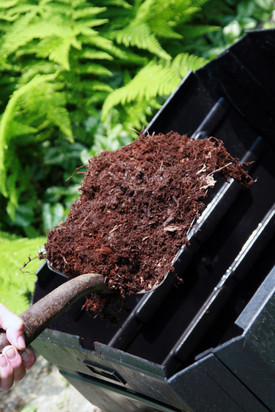Home composting is a simple task. All you need is common household and garden waste, air, a bit of heat, moisture and time for the organic materials to break down into a rich, loamy soil-like material that your plants and soil will love. If you’ve been considering composting at home, read on for inspiration and information.
Advantages of Composting at Home
Home composting is good for you and your family, your garden and the planet. Here are the basics. Compost is filled with healthy nutrients for your plants and
 |
soil. Because you choose the ingredients in your homemade compost, you don’t need to worry about harmful compost materials in your garden and yard where your children, pets and birds play. Most importantly, by composting at home, you are doing your part for the environment by putting to good use ingredients that would otherwise end up in the trash and, ultimately, a landfill.
Where to Start
You can begin to compost at any time of the year. First, you need a compost bin. Choose a well-sealed covered container to control compost temperature and moisture levels and to prevent visits from inquisitive wildlife (including rodents) and pets. Set your bin directly on well-drained soil in a sunny (or partially shaded) spot that can be reached by a garden hose. Alternate three-inch layers of “green” (wet) and “brown” (dry) compost materials, moistening each layer with water before adding the next. End with a brown layer to control odors and help start the composting process. A small, sealed composting container indoors will help to keep you organized with your composting, as well—simply add items to be composted and, when the container is full, transfer contents to the outdoor bin. Have a list nearby of what can be composted as a guide for your household.
Ingredients to Include in Your Home Compost
A healthy, beneficial compost will include an equal balance of green and brown biodegradable ingredients. Green (wet) ingredients include:
• Fresh garden and yard waste
• Raw fruit and vegetable peelings and scraps
• Crushed egg shells
• Tea bags and coffee grounds
Brown (dry) ingredients include:
• Old or dried garden or yard waste (fallen leaves, tree prunings and bark, straw and dried grass and bedding plants)
• Sawdust and wood chips from untreated, natural woods
• Shredded cardboard (including cardboard egg containers), coffee filters and non-glossy paper
Ingredients NOT to Include in Compost
Absolutely avoid these materials in your home compost: perennial weeds; unhealthy or diseased plants; meat, bones, dairy or cooked foods; carnivorous animal waste and any chemicals like cleaning products.
To Turn or Not to Turn…
A compost mixture turned and mixed well every second week will break down quickly. Some compost containers are designed to be turned or rotated easily to mix compost. You can also stir your own with a shovel or fork. However, even if compost is never turned or mixed, it will naturally decompose with time; it will just take longer.
 |
||||
|
||||
What to Do with Your Compost
After three to nine months, part of your mixture will have broken down to compost—a dark, rich, loamy material with an earthy, sweet smell—and is ready to use. Before establishing new plants in the spring, add two or three inches of compost to the garden or container soil and mix well to a depth of four to six inches. For fragile plants, your compost may be too strong, so combine it with soil and vermiculite before using. Rake in compost around the base of established perennials, shrubs, and trees, as well. The compost will nourish the botanicals during their spring growth periods, and make your soil healthier and more water retentive, too.
Compost can also be brewed into a “compost tea” (liquid fertilizer) by simply filling a cheesecloth with compost and soaking it in a pail of water for an hour or two.
Home composting is an easy and rewarding way to make a difference. Your home and yard will be safer places for your family and pets, your garden will be nourished and your soil structure healthier. You’ll be walking more lightly on the planet, as well, by sending less waste to our landfills.
About the Author
Scott Gray is a garden enthusiast who loves to relax taking care of his garden. For more information about garden planters, growing strawberries in containers and plastic garden planters be sure to visit his site, AllGardenPlanters.com.
Credit: Renovate Your World




























